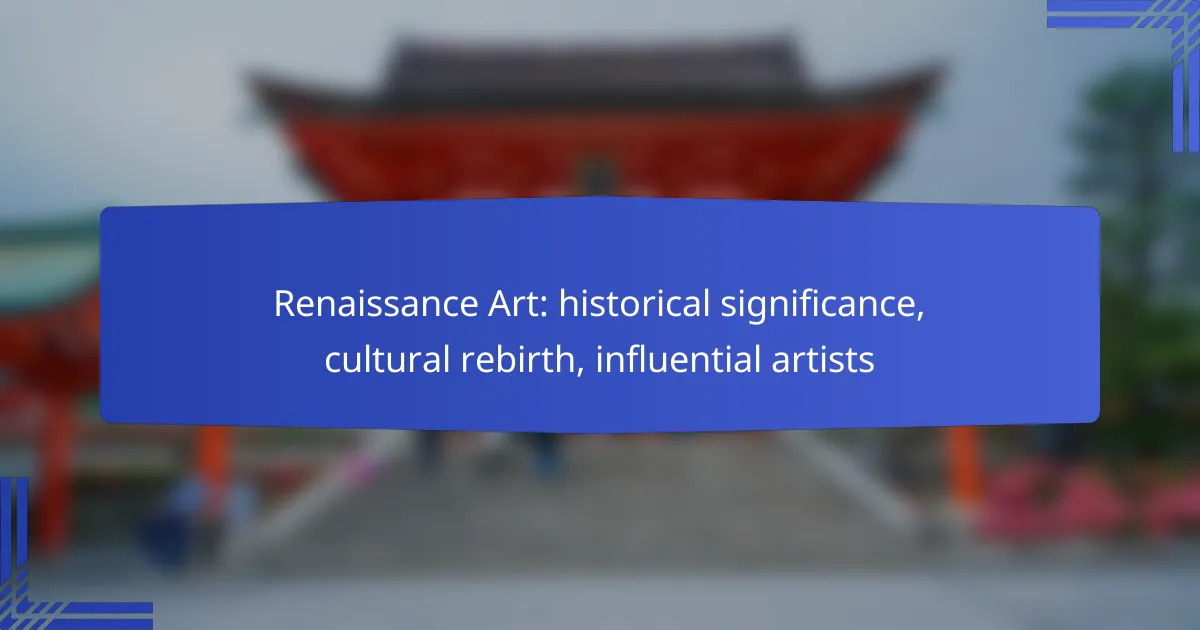Renaissance Art represents a pivotal moment in history, marked by a cultural rebirth that emphasized realism, human emotion, and classical themes. Influential artists such as Leonardo da Vinci, Michelangelo, and Raphael introduced innovative techniques that not only transformed artistic expression but also laid the foundation for modern art movements. This era’s focus on depth and accuracy in representation continues to resonate in contemporary culture.
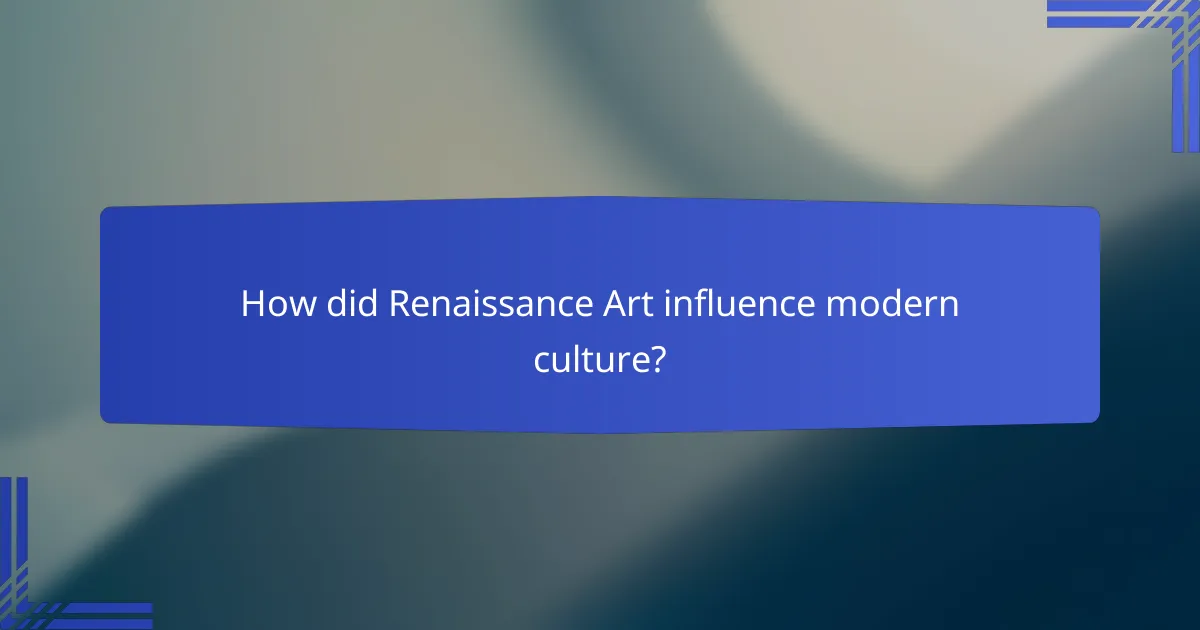
How did Renaissance Art influence modern culture?
Renaissance Art significantly influenced modern culture by introducing innovative techniques and themes that continue to resonate in contemporary artistic expressions. Its emphasis on realism, human emotion, and classical themes laid the groundwork for various modern art movements and cultural identities.
Impact on contemporary art movements
Renaissance Art has shaped numerous contemporary art movements, including realism, impressionism, and even abstract art. Artists today often draw inspiration from the techniques of perspective and chiaroscuro developed during the Renaissance, which enhance depth and emotion in their work.
For example, the use of light and shadow in modern photography and painting can be traced back to the methods pioneered by Renaissance masters like Caravaggio and Leonardo da Vinci. This historical influence is evident in the way contemporary artists explore themes of identity and human experience.
Influence on architecture and design
The architectural innovations of the Renaissance, such as the use of symmetry, proportion, and geometry, have profoundly influenced modern architecture and design. Structures like the dome of St. Peter’s Basilica set a precedent for grand public buildings, emphasizing harmony and balance.
Modern architects often incorporate Renaissance principles into their designs, leading to a resurgence of classical styles in urban planning and residential architecture. This blend of old and new can be seen in many cities worldwide, where contemporary buildings echo Renaissance aesthetics.
Role in shaping cultural identity
Renaissance Art played a crucial role in shaping cultural identity by promoting humanism and individual expression. This shift encouraged societies to value personal achievement and creativity, which are central to many modern cultures.
In various regions, Renaissance themes have been adapted to reflect local histories and identities, fostering a sense of pride and continuity. For instance, the revival of classical art forms in countries like Italy and France has reinforced their cultural heritage, influencing how they view art and history today.
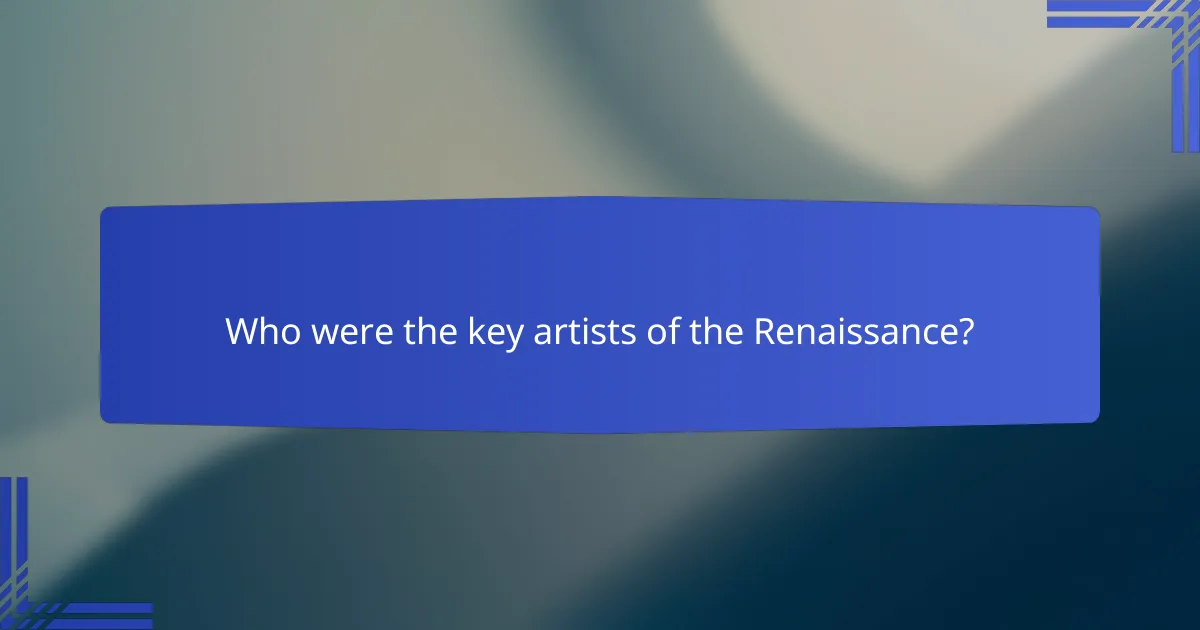
Who were the key artists of the Renaissance?
The key artists of the Renaissance include Leonardo da Vinci, Michelangelo, and Raphael, each of whom made significant contributions that shaped the course of Western art. Their innovative techniques and profound understanding of human emotion and anatomy marked a cultural rebirth that influenced generations of artists.
Leonardo da Vinci’s contributions
Leonardo da Vinci is renowned for his mastery in painting, drawing, and scientific illustration. His works, such as the “Mona Lisa” and “The Last Supper,” showcase his exceptional skill in capturing human expression and perspective.
In addition to his artistic achievements, da Vinci’s notebooks reveal his explorations in anatomy, engineering, and botany, demonstrating a holistic approach to art and science. His blending of these disciplines set a precedent for future artists and thinkers.
Michelangelo’s masterpieces
Michelangelo is celebrated for his sculptural works, particularly “David” and the “Pietà,” which exemplify his ability to convey emotion and physicality through marble. His sculptures are characterized by their intricate detail and dynamic forms.
Moreover, Michelangelo’s work on the Sistine Chapel ceiling is a monumental achievement in fresco painting, featuring iconic scenes like “The Creation of Adam.” This project not only showcases his artistic genius but also his deep understanding of human anatomy and movement.
Raphael’s influence on art
Raphael is known for his harmonious compositions and clarity of form, which greatly influenced the development of Renaissance art. His works, such as “The School of Athens,” reflect a perfect balance of perspective and human emotion.
Raphael’s ability to integrate classical themes with contemporary subjects helped to establish a standard for beauty in art. His techniques in color and composition continue to inspire artists today, making him a pivotal figure in the evolution of Western art.
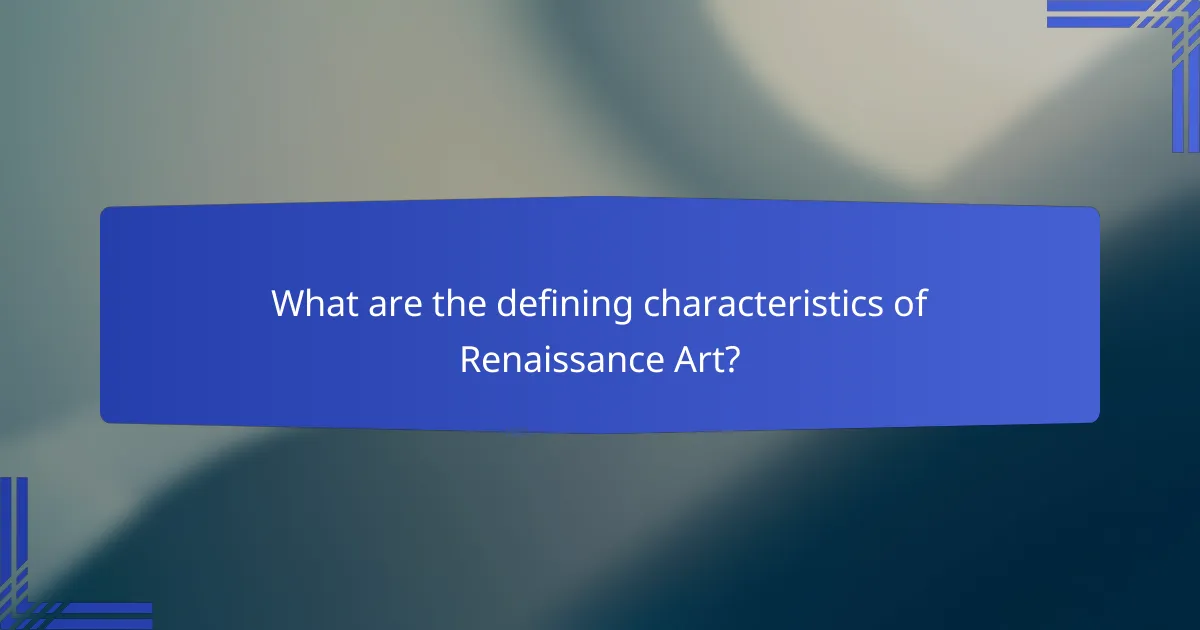
What are the defining characteristics of Renaissance Art?
Renaissance Art is characterized by its emphasis on realism, human emotion, and the use of perspective to create depth. This period marked a cultural rebirth, where artists sought to depict the world more accurately and expressively than in previous eras.
Use of perspective and depth
The use of linear perspective was a groundbreaking development in Renaissance Art, allowing artists to create the illusion of depth on a flat surface. This technique involves drawing lines that converge at a single point on the horizon, guiding the viewer’s eye into the composition.
One notable example is Leonardo da Vinci’s “The Last Supper,” where the perspective draws the viewer’s attention to Christ at the center. Artists often employed atmospheric perspective as well, where colors and details fade with distance, enhancing the three-dimensional effect.
Humanism and realism in portrayal
Humanism played a crucial role in Renaissance Art, focusing on the study of human beings and their experiences. Artists began to portray subjects with greater emotional depth and individuality, moving away from the more stylized representations of the Middle Ages.
Realism in portrayal is evident in works like Michelangelo’s sculptures, which showcase the human form with anatomical precision and expressive poses. This shift allowed for a more relatable and engaging connection between the artwork and the viewer.
Innovative techniques in painting
Renaissance artists experimented with various innovative techniques that transformed painting. One significant advancement was the use of oil paints, which allowed for richer colors and greater detail compared to traditional tempera paints.
Chiaroscuro, the technique of using strong contrasts between light and dark, became prominent, enhancing the three-dimensionality of figures. Sfumato, another technique popularized by Leonardo da Vinci, involved the subtle blending of colors and tones, creating soft transitions and a more lifelike appearance.

What historical events led to the Renaissance?
The Renaissance emerged from a series of significant historical events that transformed Europe, particularly during the 14th to 17th centuries. Key factors included the decline of feudalism, the rise of trade and commerce, and the rediscovery of classical texts, all of which fostered a cultural rebirth.
Fall of Constantinople’s impact
The Fall of Constantinople in 1453 marked a pivotal moment in European history, leading to the migration of Greek scholars to the West. These scholars brought with them invaluable manuscripts and knowledge of ancient Greek and Roman texts, which greatly influenced Renaissance thought and art.
This influx of knowledge encouraged a renewed interest in classical antiquity, prompting artists and thinkers to explore new ideas and techniques. The shift in power dynamics also facilitated the spread of Renaissance ideals across Europe, particularly in Italy.
Rise of humanism and education
Humanism, a cultural and intellectual movement, emerged during the Renaissance, emphasizing the value of human potential and achievements. This shift encouraged a focus on education, leading to the establishment of universities and the promotion of classical studies.
Humanists advocated for a curriculum based on the humanities, including literature, philosophy, and history, which fostered critical thinking and creativity. This educational reform laid the groundwork for many of the artistic and scientific advancements that characterized the Renaissance period.
Patronage by the Medici family
The Medici family, a powerful banking dynasty in Florence, played a crucial role in the Renaissance through their patronage of the arts. Their financial support allowed artists like Michelangelo, Botticelli, and Leonardo da Vinci to create iconic works that defined the era.
By funding public works and commissioning art, the Medici not only enhanced their own status but also contributed to a vibrant cultural environment. This patronage system became a model for other wealthy families across Europe, further fueling the artistic explosion of the Renaissance.
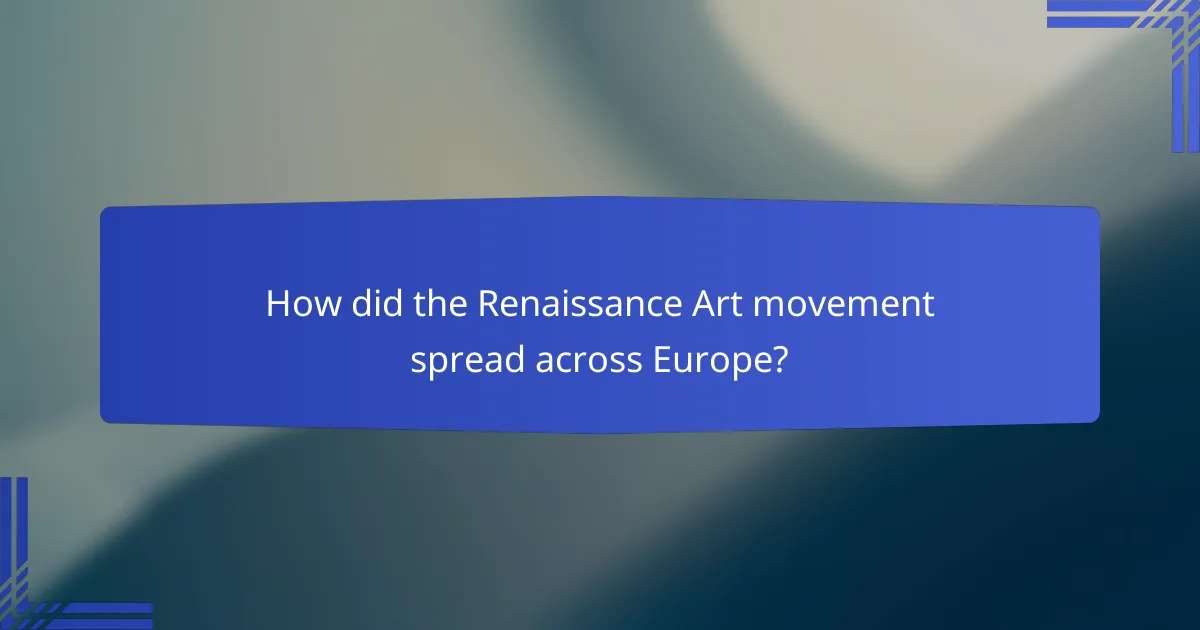
How did the Renaissance Art movement spread across Europe?
The Renaissance Art movement spread across Europe primarily through increased trade, the advent of the printing press, and cultural exchanges among artists. These factors facilitated the dissemination of new ideas, techniques, and styles, allowing the movement to flourish from Italy to other regions like France, the Netherlands, and England.
Influence of trade and commerce
Trade and commerce played a crucial role in the spread of Renaissance Art by connecting different regions and cultures. Wealth generated from trade allowed patrons to commission artworks, which in turn promoted artistic innovation and the exchange of ideas. Cities like Florence, Venice, and Antwerp became vibrant centers of commerce and art, attracting artists and thinkers from various backgrounds.
As merchants traveled, they brought back not only goods but also artistic influences from other cultures. This exchange enriched local art scenes, leading to the adoption of new techniques and themes that characterized Renaissance Art.
Role of the printing press
The invention of the printing press in the mid-15th century revolutionized the distribution of artistic ideas and knowledge. Artists could now reproduce their works and share them widely, making art more accessible to the public. This technology enabled the rapid spread of Renaissance ideals and styles across Europe, influencing both artists and patrons alike.
Books and pamphlets featuring illustrations of artworks and techniques became popular, allowing aspiring artists to learn from established masters. The printing press effectively democratized art education, contributing to the movement’s growth and reach.
Artistic exchanges between regions
Artistic exchanges between different regions were vital for the evolution of Renaissance Art. Artists traveled to study under renowned masters or to collaborate on projects, fostering a rich environment of creativity and innovation. For instance, the movement saw Italian artists influencing Northern European styles and vice versa.
Exhibitions, fairs, and cultural events also facilitated these exchanges, allowing artists to showcase their work and gain inspiration from one another. This cross-pollination of ideas led to the development of distinct regional styles while maintaining the core principles of the Renaissance movement.

What are the major themes in Renaissance Art?
The major themes in Renaissance Art include humanism, naturalism, and the revival of classical antiquity. These themes reflect a cultural rebirth that emphasized the importance of individual experience and the beauty of the natural world.
Humanism
Humanism is a central theme in Renaissance Art, focusing on the value and agency of human beings. Artists began to depict subjects with greater emotional depth and individuality, moving away from the religious iconography that dominated the Middle Ages.
This shift allowed for the exploration of secular themes, including mythology and everyday life, which became prominent in works by artists like Raphael and Michelangelo. The emphasis on human experience and emotion marked a significant departure from previous artistic traditions.
Naturalism
Naturalism in Renaissance Art refers to the accurate depiction of the human form and the natural world. Artists studied anatomy and perspective to create more lifelike representations, resulting in a greater sense of realism in their works.
Techniques such as chiaroscuro (the use of strong contrasts between light and dark) and sfumato (the soft blending of colors) were employed to enhance the three-dimensionality of figures. This attention to detail can be seen in masterpieces like Leonardo da Vinci’s “The Last Supper.”
Revival of Classical Antiquity
The revival of classical antiquity is another significant theme, as Renaissance artists drew inspiration from ancient Greek and Roman art and philosophy. This influence is evident in the use of classical motifs, such as columns and arches, as well as in the portrayal of mythological subjects.
Artists like Botticelli and Titian incorporated classical themes into their work, reflecting a renewed interest in the ideals of beauty and proportion established by ancient civilizations. This revival not only shaped the aesthetics of the time but also influenced the intellectual climate of the Renaissance.
